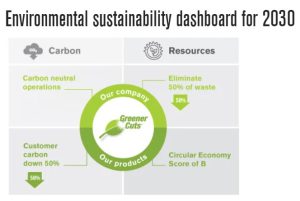We understand that human impact, from industry in particular, is a key driver of a changing and worsening climate. As we continue to learn more about the environmental effects of our products, our operations, and our supply chain, we’re not only able reduce our negative impacts, but also to find opportunities for innovation, differentiation, and leadership.
In keeping with our mission to deliver shared value for people and for the planet, we have established four environmental sustainability goals which we working to achieve by 2030. These goals are designed to reduce our waste, energy usage, and carbon emissions as we strike a balance between meeting current needs and building long-term resiliency and success in an increasingly resource-constrained world. These four goals are as follows.

Goal 1: Achieve carbon neutrality. The first goal covers Hypertherm’s direct and indirect (Scope 1 and 2) greenhouse gas emissions. Data from the Science Based Targets Initiative, an organization that sets targets in line with climate science, estimates Hypertherm would need to reduce its carbon emissions by 48 percent to help combat global warming. Hypertherm is committing to the greater goal of carbon neutrality.
Goal 2: Reduce the usage impact of Hypertherm products by 50 percent. Hypertherm will increase the energy efficiency of its products, with a set goal of reducing energy usage and the amount of scrap material that remains once cutting is complete by 50 percent.
Goal 3: Reduce waste from all waste streams by 50 percent. Hypertherm will work to reduce waste from all waste steams—including recycling and wastewater—by 50 percent. In addition, the company will build upon a previous goal to achieve zero landfill waste for its New Hampshire operations to all Hypertherm facilities around the world.
Goal 4: Achieve a circular economy score of B. Hypertherm’s final goal is to achieve a circular economy score of B. The circular economy calls for reusing, repairing, refurbishing, and recycling product instead of consuming more finite resources. Implementation of a circular economy is seen as necessary to tackle climate change, biodiversity loss, pollution, and waste. An analysis by the Ellen MacArthur Foundation, a UK-based organization that specializes in the circular economy, gives Hypertherm a current score of C.
The four goals replace Hypertherm’s 2020 environmental sustainability goals, developed in 2010. Hypertherm set eight 2020 goals in all. As a result, its products are now 100 percent recyclable and, on average, 34 percent more efficient. In addition, its global logistics network is 71 percent more efficient, its New Hampshire waste-to-landfill rate near zero, and the carbon impact of its business is 85 percent lower. You can learn more about Hypertherm’s commitment to the environment and its triple bottom line mission at www.hypertherm.com/CSR.
